Case Study prepared by Atheer Alfawzan, Carleton University
Library of Parliament in Ottawa: Sustainable Rehabilitation of a Cultural Icon
Keywords: Sustainable rehabilitation, heritage conservation, Library, Parliament, Ottawa
LESSONS LEARNED: An important relationship exists between historic or cultural conservation and sustainability. Specifically, the ways in which we can maintain our historic buildings that have cultural importance, but do it in a sustainable manner. One specific project that displays the possibilities when heritage structures are rehabilitated in a sustainable manner is the Library of Parliament in Ottawa. Some of the strategies that were used in this project to meet the goals of heritage conservation and sustainability were adaptive reuse, durability improvements, and modernization of building components. Excellent references providing guidance related to heritage conservation and sustainable rehabilitation include the Standards and Guidelines for the Conservation of Historic Places in Canada and Building Resilience, a practical guide for the sustainable rehabilitation of building in Canada.
This presentation on the sustainable rehabilitation of the Library of Parliament
DESCRIPTION: The Library of Parliament in Ottawa was constructed in 1876 and represents the last remaining part of the original Centre Block after the fire in 1916 (Government of Canada, 2017). As a result, the Library of Parliament holds a special place in the history of Canada. Starting in 2002, a major project began that focused on sustainable rehabilitation of the Library of Parliament to conserve its heritage values and improve the efficiency and durability of the structure. Some of the major aspects of the rehabilitation are discussed in more detail below.
- Preservation of existing façade (Environmental/Cultural/Economic Sustainability): elements of the structural façade of the library was removed, rehabilitated, and reinstalled on the building for preservation purposes. Not only did this help the environment by reducing waste, it also preserved the cultural heritage of the structure by maintaining its traditional appearance. It was also economically sustainable, requiring a smaller investment compared to complete replacement. In addition, the stones themselves were cleaned using a laser technology, which was effective in restoring the appearance of the structure without the use of environmentally unsafe chemicals (Government of Canada, 2017).
- Replacement of lighting systems (Environmental/Economic Sustainability): The lighting, heating, and cooling systems inside the parliament buildings were completely replaced, resulting in improved energy efficiency and building performance (Government of Canada, 2017). Although this cost more up front, it was expected that the improved efficiency of the systems would actually save money in the long-term, showcasing an example of economic sustainability.
- Removal of harmful building materials and substances (Environmental Sustainability): Harmful construction materials used during the initial construction of the Library were removed and replaced with durable alternatives (Spicer, E. J., 2007). These replacement materials are not harmful to the environment and will last much longer.
- New window systems for energy conservation (Environmental/Cultural Sustainability): The window systems in the structure were completely replaced, resulting in improved efficiency of the structure in terms of heat loss and solar gain (Government of Canada, 2017). While this improved the environmental sustainability of the project, the fact that the were the same shape and form meant that the cultural heritage of the structure remained in terms of its appearance, which is one of its character defining elements. This effectively demonstrates the relationship between heritage conservation and sustainability.
- Replacement of copper roof (Environmental/Cultural/Economic Sustainability): the copper roof of the structure was completely replaced. To ensure sustainability, parts of the roof were reused into panels that are now located inside the new Canadian War Museum (Canadian Copper and Brass Development Association, 2017). In addition, the use of copper can be seen as an economically sustainable alternative as it is expected to last for more than 100 years.
- Seismic retrofit and upgrade of structural components (Economic Sustainability): a complete seismic assessment of the structure was conducted to ensure that it would be able to withstand a major earthquake in the future (Soper, M. F., 2005). This effectively improves the durability and service life of the structure, ensuring that it will remain a cultural icon for many years to come.
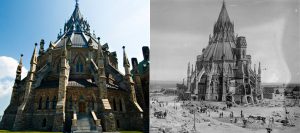
(a) Library of Parliament during construction in 1857; (b) Library of Parliament after completion of the rehabilitation and modernization project. (Images: from the Government of Canada)
TIMELINE
| 1859 | The construction of the library of parliament begins and is planned as a Gothic Revival building design in the High Victorian style. The building was designed by architects Thomas Fuller and Chilion Jones. |
| 1876 | The library opens after completion of construction. |
| 1916 | A fire broke out in the Centre Block of parliament. The use of heavy iron doors between centre block and the library saved the library from major structural damage; however, the fire caused extensive smoke and water damage to the wood floor and walls. |
| 2002 | Work begins on the Library of Parliament rehabilitation to completely modernize the exterior and interior of the structure. |
| 2006 | Work is completed on the conservation, rehabilitation, and modernization of the library of parliament building. |
Information on the history of the Library of Parliament for the timeline from Government of Canada, Explore the Library of Parliament, 2017.
- Government of Canada, including the House of Commons, the Senate, Public Services and Procurement Canada, the Parliamentary Precinct Branch
- The Library of Parliament, administration, staff and users. Sonia L’Heureux, Parliamentary Librarian of Canada
- The grounds of Parliament Hill, including those located between East and West blocks, are often treated as public park for recreational purposes by visitors.
- The National Capital Commission (NCC), a federal body whose mandate is the improvement and beautification of the National Capital Region is responsible for the landscaping and upkeep of the ground of Parliament Hill (Canada H. o., 2017).
- The Committee on the Use of Parliament Hill is responsible for determining what types of events take place at Parliament Hill and ensure that the proposed activity does not obstruct the work of parliament or have a negative impact on the heritage character of the grounds. This committee consists of a number of representatives from the Sergeant-at-Arms, Senate, the RCMP, the NCC, the Privy Council Office, and the departments of Canadian Heritage and Public Works and Government Services.
HERITAGE
The design of the Library of Parliament was inspired by the medieval chapter house, a building or room that is part of a larger cathedral. In this case, the Library of Parliament takes the form of an octagonal stone structure attached to the Centre Block of Canada’s parliament. Designed in the Gothic Revival style, the structure is easily recognizable by its richly coloured stonework, pointed-arched windows, and distinguishable steep copper roof (Canada, H. 2017). In its striking setting overlooking the Ottawa River, Library of Parliament can be seen as a structure with both natural and cultural heritage for the Canadian people.
The Library of Parliament was officially classified as a Federal Heritage building in 1987 by Parks Canada, it was classified as a national symbol of architectural and artistic merit that continues to serve its historic function in support of the operation of Parliament in Canada (Directory of Federal Heritage Designations, 2017). The fact that the structure was designed by a distinguished Canadian Architect, Thomas Fuller, adds to the cultural significance of the structure. In addition to the fact that is was the only part of the original Parliament Building to survive the fire of 1916 and as a result, plays a key role in establishing the overall character of the parliament hill complex. In addition to the structure itself, the contents of the library of parliament also a holds rare and specialized collection of more than 600,000 volumes of dealings related to parliamentary procedure, economics, finance, and constitutional law.
The character defining elements include all of the exterior chapter house form of the library and the form, surfaces and fitments of its domed reading room with radiating stacks embody its heritage character (Canada’s Historic Places, 2010). The quality of natural light in the reading room reinforces this character. As it stands this room is a fine example of sensitive adaptation; it should continue to receive equally conscientious care.
Ultimately, It is evident from the officially designated character defining elements of the structure that the Library of Parliament holds both natural and cultural heritage values (Spicer, E. J., 2007). Both natural and cultural values of the structure are considered and are explicitly stated, from the cultural significance of this building being designed by a Canadian to the natural quality of the light inside the rooms, both have been covered within the officially stated character defining elements (Potter, O. 2017).
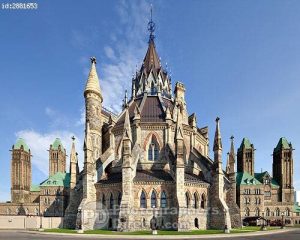
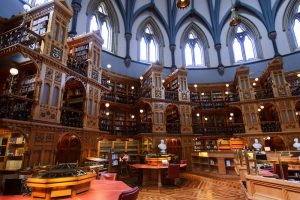
Character defining elements of the Library of Parliament: (a) exterior form; (b) quality of light in the library. Images from http://photographersdirect.com and http://valinor.ca/.
SUSTAINABILITY: It is evident from the description of the rehabilitation of the Library of Parliament that a major focus of the project was placed on sustainable principles and green initiatives. The goal of the sustainable rehabilitation was to devised solutions that were effective and long-lasting, to minimize the need for continual maintenance or future upgrades. The relationships between the rehabilitation strategies utilized and the principles of sustainability are summarized below.
- Environmental sustainability: was a primary concern in the rehabilitation of the Library of Parliament. It is clear that designers attempted to improve the efficiency of the structure by reducing its demands for natural resources through the integration of building performance optimization, new window coverings, and energy efficient lighting systems. The adaptive reuse of many exterior building components, such as the old copper roof as a decorative sculpture in the Canadian War Museum and the rehabilitation of existing ironwork reduced the total amount of waste associated with the project. In addition, an innovative laser cleaning technology was used to restore the masonry to its original condition without the need for environmentally harmful chemicals or detergents.
- Social sustainability: many aspects of the Library of Parliament rehabilitation described above relate to social sustainability and the creation of places that promote wellbeing and support social and cultural life. Through the preservation of the character defining elements of the structure as officially described by Parks Canada while at the same time making is a safer and healthier place through the removal of toxic building materials the Library of Parliament will continue to be an iconic place where people will be able to continue to gather for many years to come to celebrate the cultural heritage of Canada.
- Cultural sustainability: is evident in the sustainable rehabilitation of the Library of Parliement in its desire to maintain all of the character defining elements of the space and keep as much of the original structure as possible. For example, reuse of the original decorative ironwork, replacement of the copper roof, and restoration of the masonry façade ensure that the structure appears as intended by Thomas Fuller when the structure was first designed while also improving its durability and longevity.
- Economic sustainability: relates to the strategies being used to employ existing resources so that a responsible and beneficial balance can be achieved in the long term. In this project, upgrades to the performance of the structure in terms of energy efficiency mean that it will continue to be operationally manageable for many years to come. Replacement of key building envelope systems such as the windows and roof will ensure that the structure is durable enough to last many more years. In addition, structural retrofit of the building components and reduction of its risk to damage from earthquakes can prevent the need for major investment in the future, ensuring its economic sustainability.
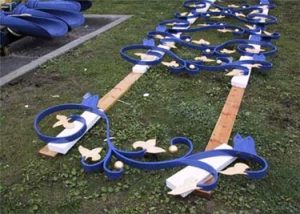

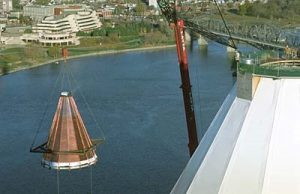
Elements of the Library of Parliament rehabilitation: (a) restored decorative ironwork; (b) laser cleaning of masonry; (c) new copper roof. Images from:Government of Canada and Canadian Copper and Brass Development Association.
MEASUREMENT: In projects that combine heritage conservation and sustainable rehabilitation together, measurement of both aspects is important to ensure that both are treated equally, such that too much emphasis is not placed on maintaining the cultural heritage of the structure or sustainability. Two excellent guidelines available on the subjects of maintaining cultural heritage and the sustainable rehabilitation of structures are Standards and Guidelines for the Conservation of Historic Places in Canada and Building Resilience: Practical Guidelines for the Sustainable Rehabilitation of Buildings in Canada (Canada’s Historic Places, 2010; Ministers of Cultural Heritage in Canada, 2016).
The Standards and Guidelines for the Conservation of Historic Places in Canada guideline provides a guide in the establishment of conservation practices that help to conserve national treasures and ensure that Canadian can learn about and experience historic places (Canada’s Historic Places, 2010). This standard is especially applicable for the Parliament of Canada, which holds significant natural and cultural heritage values for the people of Canada that should continue to be experienced by generation for many years to come. The guide outlines some features of historic structures that should be maintained to preserve natural and cultural values. These features are listed below, and their relationship to the Library of Parliament rehabilitation are noted.
While the Standards and Guidelines for the Conservation of Historic Places in Canada provides guidance/measures related to maintaining the cultural heritage of a structure, it does not connect principles of sustainability. The Building Resilience: Practical Guidelines for the Sustainable Rehabilitation of Buildings in Canada bridges the gap between heritage conservation and sustainable rehabilitation, providing measures and best practices for retrofitting heritage structures in a sustainable manner. Some of these measures are discussed below and their relationship to the Library of Parliament rehabilitation are identified.
| Heritage Conservation
(Standards and Guidelines for the Conservation of Historic Places in Canada) |
Relationship to Library of Parliament Retrofit |
| (a) Maintain Exterior Form | Masonry cleaned and restored
Copper roof replaced in original form Decorative ironwork repaired/restored |
| (b) Maintain Interior Features | Natural light remains unchanged |
| (c) Maintain Windows and Doors | New windows maintain original form |
| (d) Upgrade Mechanical and Electrical | New mechanical/electrical systems installed. |
| Sustainable Rehabilitation
(Building Resilience: Practical Guidelines for the Sustainable Rehabilitation of Buildings in Canada) |
Relationship to Library of Parliament Retrofit |
|
(a) Avoid Exterior Alteration |
This was adopted by cleaning exterior masonry and not replacing it with new materials |
| (b) Maintain Roof Elements | Although new roof installed, old elements re-used in Canadian War Museum display. |
| (c) Replace Windows for Efficiency | Windows replaced for improve energy efficiency |
| (d) Upgrade Mechanical Equipment | Mechanical equipment replaced with modern energy efficient units |
| (e) Optimize Building Performance | Building HVAC system optimized for energy usage |
| (f) Review Structural Capacity | Seismic capacity of the structure has been reviewed to ensure structural integrity |
It is evident from the results in the table above that the Library of Parliament rehabilitation project followed took into consideration both heritage conservation and sustainable rehabilitation practices when considering different aspects of the retrofit. At no point does the importance of heritage conservation outweigh the sustainable focus of the retrofit. In difficult situations where maintaining a heritage feature of the structure could potentially be environmentally unfriendly, such as complete replacement of the copper roof, a design alternative was selected to ensure the rehabilitation project remained sustainable, by relocating the old roof into an existing structure. Another example is the restoration of the historic masonry façade, which could have been environmentally unsustainable through the use of toxic chemicals and detergents, the project developed an innovative solution in the form of laser cleaning, which was both effective in maintaining the cultural heritage of the façade, but doing it in an environmentally sustainable fashion. These are only two examples, but many aspects of the Library of Parliament rehabilitation effectively balanced heritage conservation and sustainability.
REFERENCES
Articles:
- Carter, T. G., Graaf, P., Telesnicki, M., Miller, D., Webb, G., Poulter, L., & Frame, P. (2004). Excavation and support of underground excavations beneath Canada’s Historic Library of Parliament Building, Ottawa. Tunnelling and Underground Space Technology, 1.
- Spicer, E. J. (2007). Update, Rehabilitate, Conserve: The Library of Parliament 1995-2006. Ex Libris Association Newsletter.
- Soper, M. F. (2005). The Library of Parliament – Ready for a New Generation . International Association of Museum Facility Administration.
Policies and Reports:
- Canada’s Historic Places. (2010). Standards and Guidelines for the Conservation of Historic Places in Canada. Ottawa: Government of Canada.
- Ministers of Cultural Heritage in Canada. (2016). Building Resilience: Practical Guide for the Sustainable Rehabilitation of Buildings in Canada. Ministers of Cultural Heritage in Canada.
Websites:
- Government of Canada (2017). Directory of Federal Heritage Designations. Parliament Hill, Library. Retrieved from http://www.pc.gc.ca/
- Government of Canada(2017). Explore the Library of Parliament The Origins of the Library. Retrieved from https://www.tpsgc-pwgsc.gc.ca/
- Government of Canada (2017). Library of Parliament: New life for a Landmark. Retrieved from https://web.archive.org
- The Canadian Encyclopedia (2017). Parliament . Retrieved from http://www.thecanadianencyclopedia.ca/en/article/parliament/
- House of Commons (2017). House of Commons Procedures and Practices. Parliamentary Buildings and Grounds. Retrieved from http://www.ourcommons.ca
- Canadian Copper and Brass Development Association. (2017, November 26). Canadian Copper and Brass Development Association. Parliamentary Library. Retrieved from http://en.coppercanada.ca/
- Photographers Direct (2017). Photographers Direct. Library of Parliament, Ottawa, Canada. Retrieved from http://photographersdirect.com
- Government of Canada. (2017). How Parliamentary Buildings are Rehabilitated. Retrieved from https://www.tpsgc-pwgsc.gc.ca
- Potter, O. (2017). Libraries. Valinor. Retrieved from http://valinor.ca